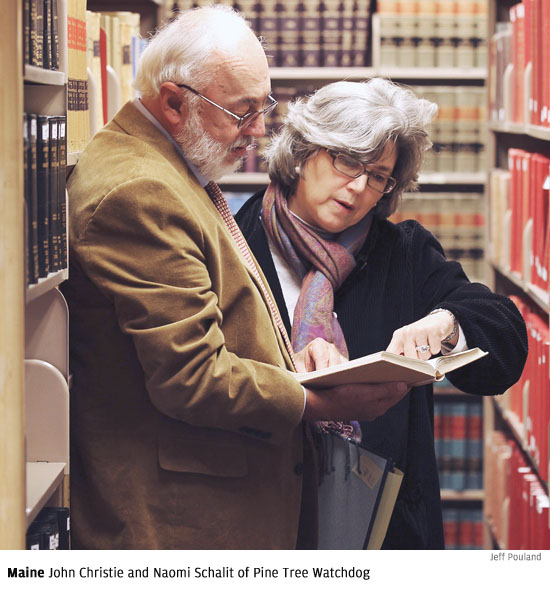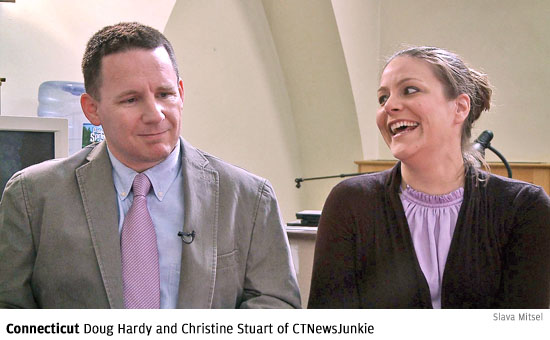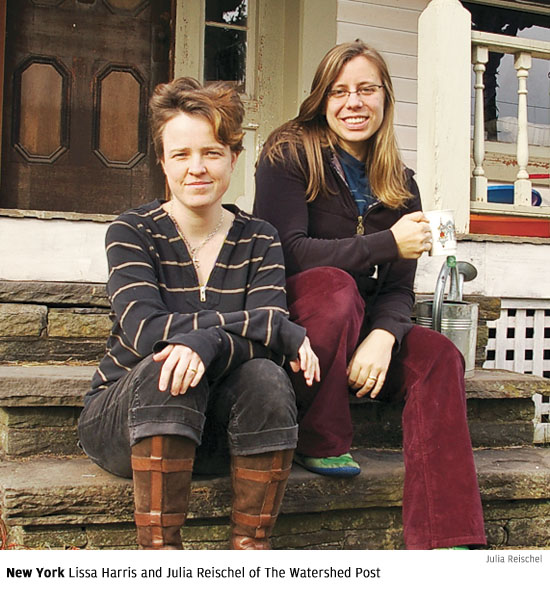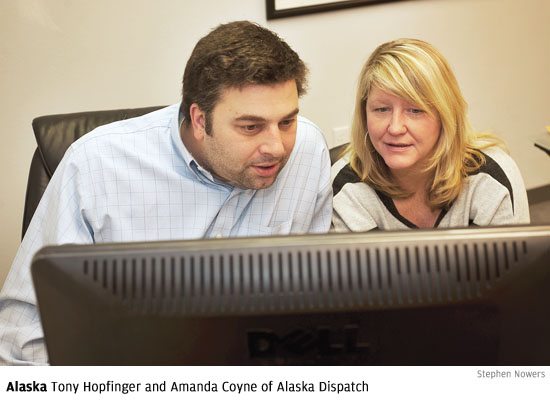In romantic relationships, it’s often the small courtesies that express love best: doing the dishes, picking up the kids, making the coffee, passing the remote. When you’re a couple running a news outlet together, such small kindnesses can take unique forms. For John Christie and Naomi Schalit, it’s the order of their names on the stories that they write together: Each insists that the other’s name appear first in the byline. They’re newlyweds, you should know.
John and Naomi, 64 and 54, respectively, run Pine Tree Watchdog, a publication of the Maine Center for Public Interest Reporting, a nonprofit grant and donor-supported investigative outlet focused on state government. Together they report, edit, and distribute their articles to 25 media partners, mostly newspapers, free of charge.

They may be newcomers in marital terms, but they are old-school reporters, and though they married and launched their site in 2010, they worked together as journalists before. John is the former publisher of The Kennebec Journal and Morning Sentinel. He hired Naomi in 2006 to be the opinion-page editor for the two dailies. Long hours discussing the editorial pages led to a relationship.
Pine Tree Watchdog is the centerpiece of their lives now. The idea is to alleviate the gap in coverage of Maine’s state government: In 1989, there were about 20 year-round reporters in the statehouse in Augusta; now there are seven, excluding Pine Tree Watchdog. Passion for the job is the fuel; neither John nor Naomi has taken a salary yet, although Naomi is supposed to at some point soon. On a good day they make trips to the statehouse and return home to file FOIA requests, talk to tipsters, and review documents (they can spend months on a complex story). On a bad day they might file taxes, write checks for freelancers, or figure out why the printer won’t work. “This is what our lives are about,” Naomi says. “We’ve kind of distilled it at this point.”
John and Naomi are just one of a number of couples who have updated the traditional family-run news business by taking it online. Couples have left their newsroom jobs behind, pooled their skills, and struck out on their own. With their eggs in one unpredictable basket, such couples tend to bring passion and commitment to the work, as in any family business. Still, the nature of a news site means round-the-clock work, and the online news business comes with no guarantee of success, or even survival, and no instruction manual. Being married to the company serves as both a strength and a weakness. It can help keep the overhead low and the intensity level high, but it also makes establishing boundaries between work and homelife a challenge.
The weight of financial stress on the mom-and-pop news operation can depend on the stage of life the site’s principals are in. Julie Ardery, 59, and Bill Bishop, 58, run The Daily Yonder, an online publication focused exclusively on rural issues, out of their home in Austin, Texas. Funded by the Center for Rural Strategies, they each split one salary and work part-time, editing stories from a stable of freelancers. In the ’80s, the pair ran The Bastrop County Times together and were in a “dog-eat-dog” competition for advertising with a publication up the road. They used to sleep with the police scanner beside the bed, and scrambled for enough income to pay their employees and the printing bill every week. But they sold the paper for a good price, which Julie says has afforded them a measure of security. They find their online news life to be much more manageable than their print life was. “The stresses of running [the Bastrop paper] were ten times what we deal with today,” says Julie. “We’re still very much working people, but we’re not putting children through college either.”
For younger couples, especially those with children or considering them, the barely-getting-paid thing can be a struggle. Christine Stuart, 34 and Doug Hardy, 42, own CTNewsJunkie, a site that is focused on state politics in Connecticut, supported by a combination of ads, donations, and sponsorships. They worked together at north-central Connecticut’s Journal Inquirer but, frustrated with the job and wary about its future, they both took a chance on online publishing. “I didn’t know if the paper would still be there when I was ready to retire,” Doug says. Christine quit first, in March 2006, and bought CTNewsJunkie from its creator, Dan Levine, who was moving and offered her the business as a respite from her frustrations at the newspaper. Eager to try something new, she dove in, supplementing her income with a part-time court-reporting job, while Doug continued working at the Inquirer, mostly for the benefits. “It took me several years to come to the conclusion that I’m killing myself for health benefits,” he says. He quit in March 2011, and is CTNewsJunkie’s business manager; Christine is the editor. They both juggle other gigs to stay on top of their finances, and say their for-profit operation wouldn’t make it if they had to pay for office space, or if they had children. They describe their $10,000-deductible health insurance—the most affordable plan they could find—as “birth control.” “We’re looking at a $10,000 ransom note if we have a kid,” Doug says.

Frank Carini, 44, and Joanna Detz, 37, also say they wouldn’t try to run a news website with a child. They publish ecoRI News, a donor and ad-supported nonprofit site that focuses on environmental issues in Rhode Island. The pair met at Community Newspaper Co. in Boston in the ’90s, where Frank was an editor and Joanna a reporter. She left in the late ’90s to get into graphic design, but Frank stayed, and his frustration with what happened to journalism over the years is palpable. “I’ve heard so many times, ‘Do more with less and fill the paper,’” he says. “I was tired of the mainstream media, the cuts, that whole sad story.”
Having their own news outlet was an idea the couple had always tossed around. “We’d talk playfully about what journalism friends we knew, what their strengths would be,” Joanna says. “How you talk when you’re enjoying a cocktail and daydreaming.” She was relieved when Frank decided to quit his job at the Newport Daily News in late 2008; she didn’t like seeing him so discouraged. They refinanced their house and converted their basement into the office. Joanna still has a full-time job as a graphic designer, but helps with the site after work and on weekends.
Frank has been able to hire four people to report and write, paying them a monthly salary depending on what he can afford. Frank hasn’t taken a salary for himself yet. He says the financial strain is by far the hardest part. But both think that the site is good for their marriage. “We don’t have children, so I think in a healthy relationship, you need to be working toward something,” Joanna says. “It’s really nice to have that thread.”
For 35-year-old Lissa Harris and her wife, 30-year-old Julia Reischel, running a news site together is infinitely more appealing than clinging to someone else’s masthead. “It’s more exciting to do something new together, in untested territory, than to play musical chairs for the same shrinking number of jobs,” says Lissa. Together, they run The Watershed Post, a for-profit site, supported by grants and ads, covering five counties in the Catskills region of upstate New York.
Still, sharing work can be a challenge: “We’re always guilt-tripping each other about work,” says Julia. While being interviewed for a radio show in front of a live audience recently, she says, they kept interrupting each other, flashing disapproving looks. “We were getting stressed out over each other’s answers to the questions,” Lissa says. “I’m sitting there thinking, ‘Oh my God, do we look like the world’s worst bickering lesbians? Can everyone tell? And does it matter? Or are we just such an obvious married couple?’”

The two met in 2005 while working at The Weekly Dig in Boston. They wanted to have children, and running a news business together had some strategic advantages. “It’s tough in journalism to find a job that pays enough to justify the cost of not being home,” says Lissa. In 2007, Lissa got pregnant by artificial insemination (a longtime friend is the biological father). After the birth in 2008, Julia adopted the child, and the family of three moved up to Lissa’s father’s house in the Catskills to begin building The Watershed Post. For those first few months, they “lived like church mice in a tiny room,” says Julia. “It was very startup-py, in the we-aren’t-going-to-spend-a-dime kind of way.”
They’ve come a long way since then—into their own apartment, for one thing. And they won the “new business of the year” award from the Delaware County Chamber of Commerce. More important, when Hurricane Irene ravaged the Catskills, Lissa and Julia became local heroes, coordinating relief efforts via the site as part of their coverage. A card recently arrived in the mail with hundreds of thank yous from people in the community. “It feels like having a mission as a couple,” Lissa says. “Our lives are a lot bigger than just spending time together.”
What happens when two passionate, married journalists discover a story in their own backyard that involves corruption, money, politics, drugs, and underage prostitution? “An obsession,” says Amanda Coyne.
When the FBI and IRS raided Alaska State Senator Ted Stevens’s home in 2007, Tony Hopfinger, 37, and Amanda Coyne, 45, went digging. A political kingmaker, Bill Allen, whose company, VECO, had renovated Stevens’s home, was suspected of bribing politicians to keep oil taxes low. When an off-the-record source mentioned tales of Allen’s love for underage, crack-addicted girls, Tony and Amanda were on it. The eventual scoop couldn’t have come at a better time.
Two years before this story came into their lives, Amanda and Tony had both, within weeks of each other, quit their jobs at the Anchorage Press. At first, they struggled to find enough freelance work, and worried that they had made the wrong move. Amanda got a job teaching writing at Alaska Pacific University. Tony took a gig moving boxes for FedEx at the airport, and eventually found correspondent work with Newsweek and Bloomberg.
As Tony and Amanda went deeper into the corruption saga, they found they had great stories to sell. But weary of getting scooped by the local daily, they were apprehensive about querying editors there, and while the national publications Tony wrote for were biting, they were only interested, he says, in tidbits and crumbs. The full story was going untold. “We weren’t getting paid by anybody,” says Amanda. “We were going in the backwoods to track people down, driving country roads late at night, looking through court documents.” It was a competitive story, and the pair knew they were way out in front. “We were hot to get things out quickly,” says Tony.

So they decided to start a website and publish stories on their own. They launched Alaska Dispatch on August 13, 2008. The timing couldn’t have been better: By the end of the month, John McCain had picked Sarah Palin as his running mate, and interest in Alaska exploded. They sold their corruption story as a book, Crude Awakening: Money, Mavericks, and Mayhem in Alaska, to Nation Books.
For the first year, the couple wrote the bulk of the stories for Alaska Dispatch, worked on the book, and kept their teaching and correspondent jobs. They soon realized they couldn’t sustain the site by themselves, and started looking for investors. They met Alice Rogoff, the former CFO of US News & World Report, a woman with a passion for local journalism. In 2009, Rogoff purchased 90 percent of Alaska Dispatch—a for-profit fueled by advertising and sponsorships—allowing Tony and Amanda to hire a staff and mold it into a full-fledged news operation. Within two years, Alaska Dispatch was able to call itself the second most-trafficked news site in the state.
Tony and Amanda have been working morning to night for the past few years. But they say it suits them. “It’s not like we’re going to focus on quality of life—that’s not us,” Amanda says. “We have our website; it’s our baby and we love it.” Separating work from personal life isn’t a priority. “We’re having fun, so does it matter if we’re talking about work?” says Tony. “Maybe it’s not the conventional way a couple would have a marriage, but this is what we do.”
High intensity doesn’t always yield good results. Steve and Melinda Taylor, 53 and 52 respectively, started the Rio Grande Guardian in 2005. It was Melinda’s idea to start an outlet that focused on news about the border. When Steve agreed, she sold her Isuzu for $3,000 worth of seed money. Melinda doesn’t have a journalism background, but Steve is a veteran political reporter. He was to take care of the editorial side of things, and she was to be the publisher.
Despite their separate tasks, they had a lot of disagreements over the site’s direction. “It’s not easy to compartmentalize when you’re both working for the same business, especially if you own it,” says Steve. And when you feel as passionately about the topics as they do, it can be hard not to let the site take over your life: “Our pillow talk was not, ‘Oh, baby, your eyes are so beautiful,’” says Melinda. “Our pillow talk was, ‘That fucking asshole. Did you see how he worked with the lobbyist? Did you see what he did in committee? It’s time for us to expose what’s going on.’”
Melinda wanted the site to be comprehensive, and cover a variety of topics, from business to education to lifestyle. But Steve had a penchant for politics. When the site expanded and they were able to hire some reporters, things went south. Melinda felt that Steve was “hijacking” her reporters and sending them on too many political stories. Running a news operation together “was like frying bacon naked,” says Melinda. “It hurts; it’s maddening, even if the end result tastes fantastic.” The strain on their marriage became too much. “I realized our baby, the thing we had conceived together, wasn’t going to be what I wanted it to be,” says Melinda. In 2008, after ten years of marriage, they divorced. Melinda sold her share of the business to Steve, which he still runs.
Other couples who run websites do say that having distinct and clearly defined roles can really enhance the chances of success, both personally and professionally. Tracy Record, 52, runs West Seattle blog with her husband, Patrick Sand, 55. She’s in charge of editorial and Patrick handles the business end. “It just doesn’t work if everybody is accountable for everything,” she says. West Seattle blog, supported by advertising, is one of the nation’s more successful local news sites, with more than a million page views this past October. Tracy and Patrick say it is making money. Two years ago, they won a community-service award from the American Legion branch in West Seattle and rode near the front of a local parade, which Tracy described as “perhaps the coolest moment of the whole thing.”
Olwen and Nigel Logan, 56 and 57 respectively, make a concerted effort to keep work life and personal life separate. They own Shoreline Web News LLC, and operate three websites: Lyme Line, Old Saybrook Now, and Valley News Now. They split up the sites; Olwen is in charge of Lyme Line, and Nigel runs the Old Saybrook site and Valley News Now. Drawing a clear line between work and home life is a priority for them, especially since they have four kids, ages 16 to 24. “It’s important to turn it off,” Olwen says. “Now we’re working. And now we’re not. The kids don’t want to just hear about this all the time.” They each have their own offices and do almost all of their work communication through e-mail, even when they are in the house at the same time. “There’s a discipline that comes out of communicating by e-mail. It avoids miscommunication and sets a more businesslike framework,” Nigel says. “You can’t say, ‘Can we sit down and work out a marketing plan, and by the way, don’t forget to take the trash cans out and pick up George from soccer.’ You can’t mix up normal household conversation with work things—at least we can’t.”
Still, Laurie and Joel Kramer, both 63, who together run MinnPost, serving Minneapolis and St. Paul, often find themselves mixing business with the rest of life. Laurie had worked in nonprofits most of her career; combining Laurie’s nonprofit knowledge with Joel’s knowledge of journalism and publishing, they created their nonprofit in 2007. This blend of talents has enabled them to think big: MinnPost has never had a budget under a million dollars. The pair, who met at their high school newspaper in Queens, NY, lead a newsroom with a full-time staff of 17 and about a dozen writers on contract. Stock proceeds from the sale of the Star Tribune to McClatchy more than a decade ago have allowed them to work without a salary—at least for now.
Five years in, though, the work remains intense. About the only time they take off is to visit their three grown sons and four granddaughters. Even then, they say, “as soon as we open our mouths it’s something about the MinnPost,” Laurie says.
“It’s on our minds!” Joel exclaims, as they both start laughing.
Alysia Santo is a former assistant editor at CJR.
